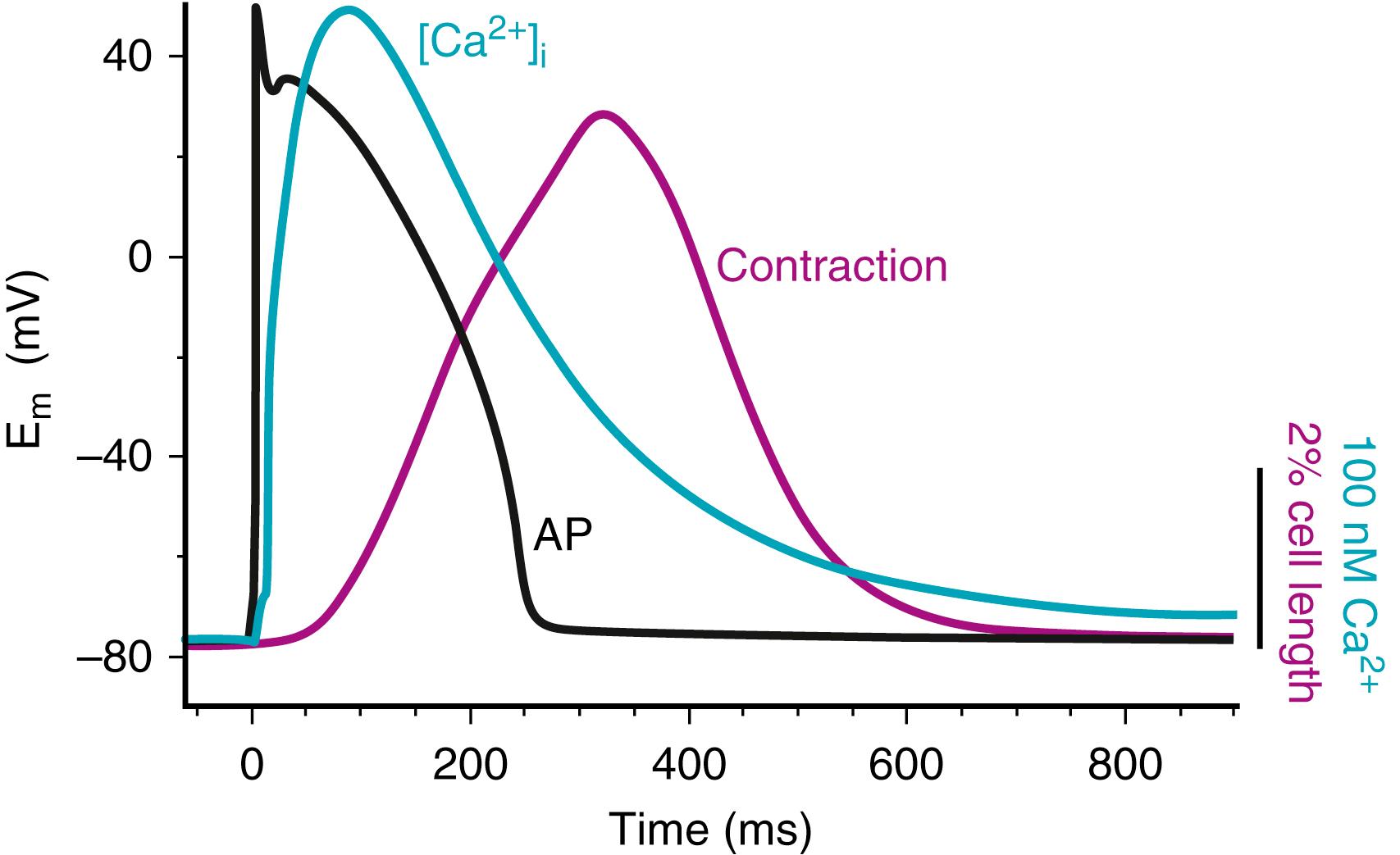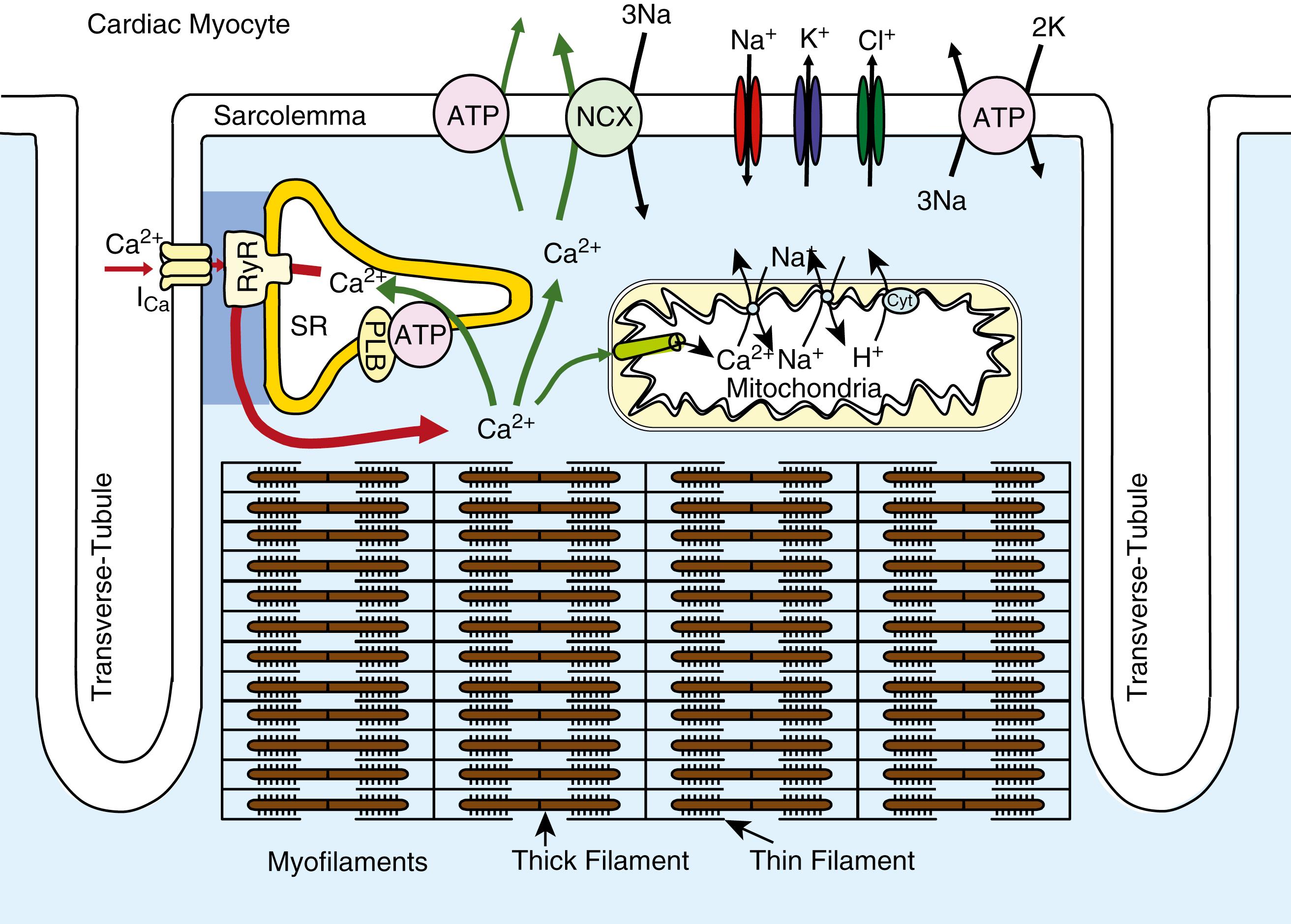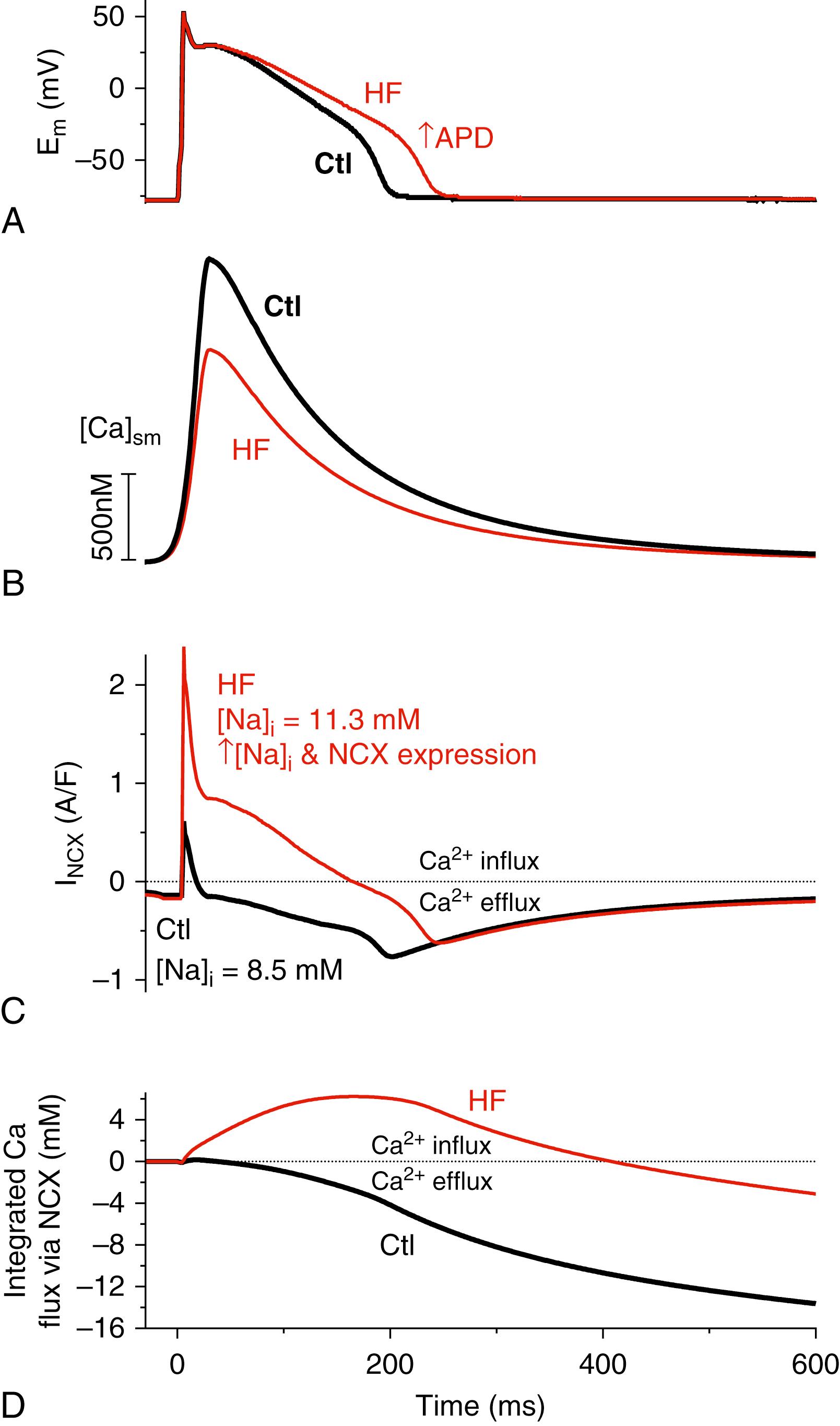Physical Address
304 North Cardinal St.
Dorchester Center, MA 02124
Cardiac excitation-contraction coupling (ECC) is the process by which the electrical activation of cardiac myocytes leads to the activation of contraction. – In the broadest sense, ECC refers to everything from the initial membrane depolarization through the action potential (AP) to the activation of the Ca 2+ transient, including how the myofilaments respond to the Ca 2+ transient to produce contraction. Fig. 16.1 shows the temporal superposition of contraction and changes in membrane potential (E m ) and intracellular Ca 2+ ([Ca 2+ ] i ), as measured in a rabbit ventricular myocyte at 37°C during 1-Hz stimulation. This chapter focuses on the initiation of normal and abnormal Ca 2+ transients in myocytes, Ca 2+ transport and buffering mechanisms, and the interaction of Ca 2+ signaling with the AP and arrhythmias. Recently, it has increasingly become clear that Ca 2+ signaling and cardiac electrophysiology are inextricably interrelated; thus understanding myocyte Ca 2+ regulation is essential to understanding cardiac arrhythmogenesis.

Fig. 16.2 shows the structural organization of key mediators of ECC in myocytes. The voltage-dependent Na + current (I Na ) drives the depolarizing AP upstroke, which activates Ca 2+ influx via Ca 2+ current (I Ca ) and Ca 2+ release from the ryanodine receptor (RyR) in the sarcoplasmic reticulum (SR) that causes myofilament activation. Ventricular myocytes have a network of transverse tubules (T-tubules) that dive into the cell center, perpendicular to the long axis of the myocyte. This T-tubular system also exhibits longitudinal extension in most myocytes. The role of the T-tubular system is to synchronize the sarcolemmal electrical signal (an AP) at junctions throughout the cell where the plasma membrane and SR are in close proximity to each other, mediating Ca 2+ -induced Ca 2+ release. During heart failure the T-tubule network is less extensive than in a healthy heart, , which can reduce ECC efficacy.

Atrial myocytes have fewer T-tubules than ventricular myocytes, and the specialized conduction fibers (sinoatrial and atrioventricular node and Purkinje fibers) have almost no T-tubules. In cells or regions that lack T-tubules, I Ca initiates SR Ca 2+ release only at the surface membrane junctions. Then, depending on conditions discussed later, activation can more slowly propagate to the center of the myocyte (via a chain of RyR clusters) as a wave of Ca 2+ -induced Ca 2+ release, but it can also fail to propagate such that the surface Ca 2+ release produces only a small and slow diffusion-dependent [Ca 2+ ] elevation near the cell center, which limits contraction.
The rise in global [Ca 2+ ] i activates contraction in the myofilaments. Ca 2+ binds to troponin C on the thin filaments, inducing a conformational change that allows the heads of the myosin molecules located along the thick filament to bind to the actin molecules that form the body of the thin filament (see Fig. 16.2 ). Myosin then uses energy stored as adenosine triphosphate (ATP) to tilt the myosin head, pulling on the actin filament to create either force and sarcomere shortening, which are responsible for isovolumic pressure development and ejection of blood from the heart, respectively. Synchronization of local Ca 2+ transients throughout the myocyte and the heart is thus essential for synchronous ventricular contraction. The strength of contraction is directly related to the [Ca 2+ ] surrounding the myofilaments. Thus a myocyte (or region thereof) that has a small Ca 2+ transient will be weaker than adjacent areas. Furthermore, this weaker myocyte can limit the strength of stronger neighboring regions, which may expend their strength by stretching their weak neighbor and result in reduced cardiac output. Readily appreciable consequences of this mechanical dyssynchrony include ischemia, spatially discordant cardiac alternans, and ventricular fibrillation.
Another point worth mentioning is that Ca 2+ signaling is highly localized, acting only within 1 to 3 μm and contrasting with electrical signals, which can spread over millimeter distances. The localized nature of Ca 2+ signaling means that the distribution of Ca 2+ entry into the cell and SR Ca 2+ release must be quite uniform spatiotemporally, even within a single myocyte, to ensure proper function. In contrast, because of the millimeter-scale electrical space constant in the heart, one could have potassium channels in every other myocyte only, and electrical signaling could remain satisfactory.
For cardiac relaxation and ventricular refilling to occur, [Ca 2+ ] i must decline, allowing Ca 2+ to dissociate from troponin C and terminating myofilament crossbridge cycling. This reduction in [Ca 2+ ] i is driven by Ca 2+ transport, mainly via the SR Ca 2+ -ATPase and the sarcolemmal Na + /Ca 2+ exchanger (NCX; discussed later). Ca 2+ movement across the sarcolemma via Ca 2+ channels and the 3Na + :1Ca 2+ electrogenic NCX both carry charge; thus they also affect the AP and excitability. Further, there are other Ca 2+ -sensitive channels whose electrophysiologic impact is regulated by their local [Ca 2+ ] i . Thus it is important to integrate our understanding of Ca handling into an electrophysiologic framework.
With reference to the cytosolic compartment, where the myofilaments reside and with which the sarcolemma, SR, mitochondria, and nucleus interface, we can consider the sources of Ca 2+ that cause cytosolic [Ca 2+ ] to rise and sinks that cause cytosolic [Ca 2+ ] i to decline. Ca 2+ channels (L-type and T-type) and the NCX are the main pathways of Ca 2+ entry. However, the electrochemical driving force for Ca 2+ influx is quite large because of a 20,000-fold concentration gradient (external = 2 mM; diastolic [Ca] i = 100 nM) and a resting E m of –80 mV; thus even a slight additional Ca 2+ permeability through a means other than these two transporters could constitute an additional nonnegligible “Ca 2+ leak” pathway (e.g., connexin 43 hemichannels). During diastole, the Ca 2+ channels are tightly closed and NCX (which is reversible) functions predominantly in the Ca 2+ extrusion mode (as a small inward current).
During the AP, voltage-dependent Ca 2+ channels open and allow Ca 2+ to enter the cytosol flowing down its electrochemical gradient, causing an inward depolarizing current (see Chapter 2 for Ca 2+ channel gating details). In ventricular myocytes, I Ca is mediated nearly entirely by L-type Ca 2+ channels (LTCC) and in particular by the Ca V 1.2 isoform, whose activity can be promoted by interaction with the cytoskeletal protein α-actinin. However, atrial, and especially pacemaker cells, also express the Ca V 1.3 LTCC isoform, which activates at a more negative E m than does the Ca V 1.2 isoform. Thus it can more effectively contribute to late phase 4 depolarization in pacemaker cells and recruit additional Ca V 1.2 channels.
T-type Ca 2+ channels are also seen in atrial, pacemaker, and conduction fibers, but not in ventricular myocytes (except in neonatal myocytes and in some pathophysiologic settings). These channels activate at an even more negative E m than LTCCs, but they also inactivate much more rapidly. T-type channels can contribute to triggered or pacemaker activity, but they produce a much smaller peak I Ca and integrated Ca 2+ influx than LTCCs. Additionally, T-type Ca 2+ channels cannot effectively substitute for LTCC in triggering SR Ca 2+ release, likely because they do not localize at the sarcolemmal-SR junctions where Ca 2+ -induced Ca 2+ release occurs during ECC. Thus the remainder of the chapter relates mainly to Ca V 1.2 LTCCs.
I Ca is activated by depolarization and exhibits both E m - and Ca 2+ -dependent inactivation (CDI) (voltage-dependent inactivation and CDI, respectively), and CDI is by far the dominant physiologic mode of I Ca inactivation. Indeed, when CDI is abrogated experimentally, AP duration (APD) becomes extremely long and cells tend to overload with Ca 2+ . Calmodulin (CaM) is constitutively bound to the Ca V 1.2 in myocytes, and it senses local [Ca 2+ ] i elevation to cause channel inactivation. Although Ca 2+ entry via the channel itself can contribute to CDI, most LTCCs in cardiac myocytes are localized to junctional clefts with the SR and RyR, and the Ca 2+ -induced SR Ca 2+ release is even more powerful in causing CDI. The integrated amount of Ca 2+ influx via I Ca in ventricular myocytes during a normal AP is 5 to 10 μmol/L cytosol, but it is about twice that concentration when SR Ca 2+ release is blocked. To place this Ca 2+ flux in context, the amount of SR Ca 2+ release in mammalian ventricular myocytes is normally 3 to 10 times larger than this, depending on species and conditions. The regulation of SR Ca 2+ release is discussed in more detail later.
NCX can also contribute to the rise in [Ca 2+ ] i , but Ca 2+ entry via NCX is normally quite small (<1 μmol/L cytosol) and is constrained normally to the very early part of the AP. NCX can bring Ca 2+ in or out (outward or inward current) during the AP, depending on the trans-sarcolemmal [Na + ] and [Ca 2+ ] gradients and on E m . During diastole, the E m is negative to the electrophysiologic reversal potential for NCX (E NCX = 3E Na − 2E Ca ), so Ca 2+ efflux and inward I NCX are thermodynamically favored ( Fig. 16.3 ). , However, the low diastolic [Ca 2+ ] i kinetically limits the amount of transport because of low substrate concentration. The peak of the AP exceeds E NCX and briefly favors Ca 2+ influx (an outward current). However, as soon as I Ca and SR Ca 2+ release begins, the local [Ca 2+ ] i in the cleft and submembrane space ([Ca 2+ ] sm ) is much higher than the average [Ca 2+ ] i and drives Ca 2+ extrusion via NCX (see Fig. 16.3C ). The declining E m during repolarization also more strongly favors Ca 2+ efflux, and that situation persists throughout [Ca 2+ ] i decline and diastole. Thus NCX is mainly functioning as a Ca 2+ efflux mechanism, except in certain pathophysiologic conditions. For example, in heart failure where [Na + ] i is elevated, NCX expression is elevated, Ca 2+ transients are small, and APD is prolonged (see Fig. 16.3 ). All of these factors shift NCX more in favor of Ca 2+ influx, and so in heart failure Ca 2+ entry via NCX can persist for most of the AP plateau and can significantly contribute to the Ca 2+ transient. In a sense, this greater Ca 2+ influx limits the extent of cardiac dysfunction in heart failure by bringing Ca 2+ in and by indirectly helping load the SR with Ca 2+ ; however, it also means that this Ca 2+ must be extruded during diastole, and any inability to do so would promote diastolic dysfunction and arrhythmogenic activity.

So how much Ca 2+ enters the cytosol during the AP, and where does it go? The total Ca 2+ from I Ca , NCX, and SR Ca 2+ release is between 50 and 100 μmol/L cytosol. Notably, this is also the total Ca 2+ entering the myoplasm, which contains many Ca 2+ buffers (e.g., troponin C, the SR Ca 2+ -ATPase, CaM, membrane lipids, ATP, etc.). The most quantitatively dominant Ca 2+ buffers are troponin C and the SR Ca 2+ -ATPase, which are present at approximately 70 and 50 μmol/L cytosol, respectively, and have affinities in the 0.5 μM range. Overall, the cytosolic buffering is approximately 100:1, such that 50 to 100 μmol/L cytosol of added Ca 2+ only raises the free [Ca 2+ ] i to approximately 500 to 1000 nM. However, that concentration suffices to partially saturate troponin C and activate contraction. Notably, Ca 2+ buffering does not directly remove Ca 2+ from the cytosol, and energy-dependent Ca 2+ transport is required to return [Ca 2+ ] i and cytosolic buffers back to their diastolic levels.
Four transporters work in parallel to bring [Ca 2+ ] i down and drive relaxation: (1) the SR Ca 2+ -ATPase, (2) NCX, (3) the plasma membrane Ca 2+ -ATPase, and (4) mitochondrial Ca 2+ uptake. , We have analyzed quantitatively how these processes compete in myocytes from different mammalian species. In rabbits (and similar in humans, canines, felines, ferrets, and guinea pigs), the percent contribution to [Ca 2+ ] i decline is roughly 70%, 28%, 1%, and 1%, respectively. Thus the SR Ca 2+ -ATPase is the dominant transporter, by a factor of 3 over the NCX. In rat and mouse ventricular myocytes, these numbers are 92%, 7%, 0.5%, and 0.5% and so is much more SR dominated (14-fold over NCX). In heart failure, there is generally a downregulation of SR Ca 2+ -ATPase and an upregulation of NCX, such that in rabbit and human heart failure, the SR and sarcolemmal removal fluxes are quantitatively similar. Although fewer data are available regarding atrial myocytes, the estimate for human atrial myocytes is that 66% and 25% of Ca 2+ removal occurs via the SR Ca 2+ -ATPase and NCX, respectively. In chronic atrial fibrillation, as in heart failure, this predominance of SR Ca 2+ -ATPase over NCX changes to more equal contributions of SR Ca 2+ -ATPase and NCX (46% vs. 44%). ,
Mitochondria take up Ca 2+ during normal heartbeats via the mitochondrial Ca 2+ uniporter, but as stated earlier, this is only approximately 0.5 μmol/L cytosol (approximately 1 μmol/L mitochondria). Significant Ca 2+ buffering occurs in mitochondria that is packed with proteins (as in the cytosol), so the rise in free [Ca 2+ ] in the mitochondria at each beat is small (approximately 20 nM). The extrusion of Ca 2+ from mitochondria is mediated primarily by the mitochondrial Na + /Ca 2+ exchanger (NCLX), which differs molecularly from the sarcolemmal NCX. This Ca 2+ extrusion occurs quite slowly, such that at higher heart rates diastolic mitochondrial [Ca 2+ ] gradually accumulates to a higher steady-state level. Notably, mitochondria in different regions of the myocyte differ somewhat in their Ca 2+ handling and sensitivity to stress.
One important effect of increased mitochondrial [Ca 2+ ] is that it binds to and stimulates several dehydrogenase enzymes in the mitochondria to increase the rate of nicotinamide adenine dinucleotide (NADH) production and, consequently, the rate of ATP production. This is an important feedback pathway by which the mitochondria ramp up their ATP production under conditions when the myocyte is using more ATP (i.e., when Ca 2+ transients are more frequent and/or of higher amplitude). When heart rate is reduced, the diastolic Ca 2+ efflux is more able to keep up with the less frequent influx pulses, and mitochondrial [Ca 2+ ] gradually falls.
Under severe cellular stress, mitochondria can store large amounts of Ca 2+ , in part by progressively increasing their buffering capacity, which is thought to provide temporary protection for the myocyte against the dangers of Ca 2+ overload. However, excessive Ca 2+ loading in the mitochondria can lead to increased oxidative stress and opening of the permeability transition pore and loss of proteins, which can cause mitochondrial death.
Become a Clinical Tree membership for Full access and enjoy Unlimited articles
If you are a member. Log in here